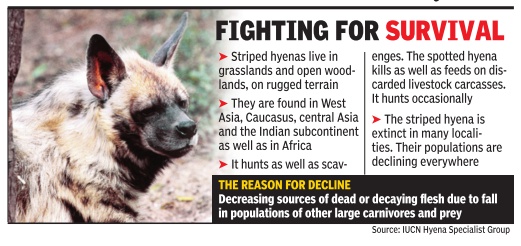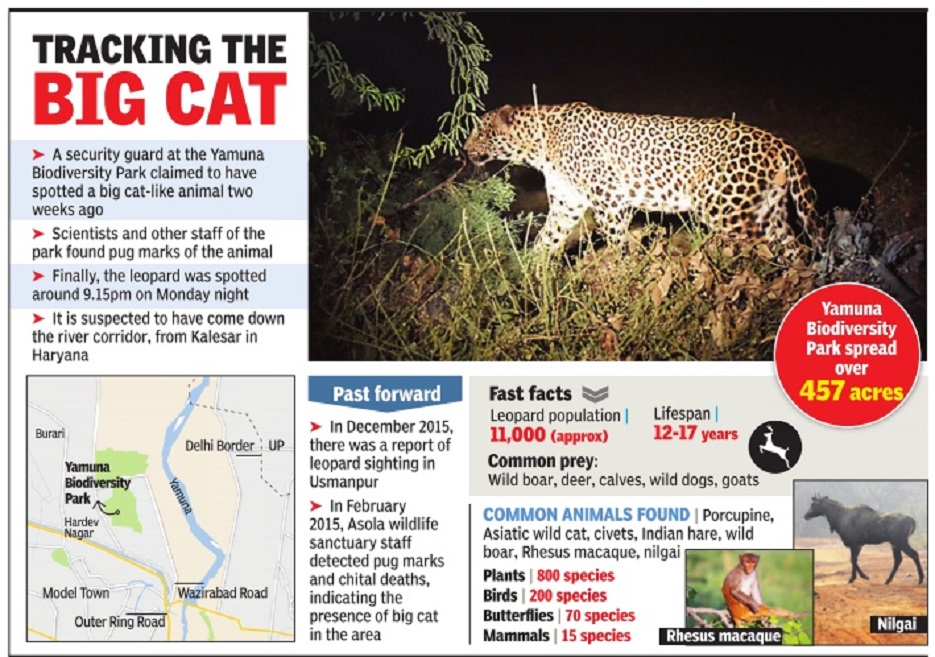Delhi: Wildlife (Fauna)
(→Hyena) |
(→Pugmarks in 2015, sighted in 2016) |
||
| Line 34: | Line 34: | ||
Asola Bhatti sanctuary is a small area of 4,707 acres in Maidan Garhi, notified in 1986, and about 2,167 acres in Bhatti, notified in 1991. But it shares a border with the Faridabad frontier of the Aravalis, making it an important wildlife corridor. The department is in talks with the Haryana government to secure an eco-sensitive zone shared between the two states. | Asola Bhatti sanctuary is a small area of 4,707 acres in Maidan Garhi, notified in 1986, and about 2,167 acres in Bhatti, notified in 1991. But it shares a border with the Faridabad frontier of the Aravalis, making it an important wildlife corridor. The department is in talks with the Haryana government to secure an eco-sensitive zone shared between the two states. | ||
== Leopard== | == Leopard== | ||
| − | ===Pugmarks | + | ===Pugmarks: 2015, sighting: 2016=== |
| + | [[File: A leopard was spotted in the Yamuna Biodiversity Park in Nov 2016a.jpg| A leopard was spotted in the Yamuna Biodiversity Park in Nov 2016|frame|500px]] | ||
| + | [http://epaperbeta.timesofindia.com/Article.aspx?eid=31808&articlexml=Leopard-takes-up-residence-in-Delhi-biopark-23112016001039 Jasjeev Gandhiok, Leopard takes up residence in Delhi biopark, Nov 23 2016 : The Times of India] | ||
[[File: A leopard was spotted in the Yamuna Biodiversity Park in Nov 2016.jpg| A leopard was spotted in the Yamuna Biodiversity Park in Nov 2016|frame|500px]] | [[File: A leopard was spotted in the Yamuna Biodiversity Park in Nov 2016.jpg| A leopard was spotted in the Yamuna Biodiversity Park in Nov 2016|frame|500px]] | ||
[http://epaperbeta.timesofindia.com/Article.aspx?eid=31808&articlexml=Leopard-takes-up-residence-in-Delhi-biopark-23112016001039 Jasjeev Gandhiok, Leopard takes up residence in Delhi biopark, Nov 23 2016 : The Times of India] | [http://epaperbeta.timesofindia.com/Article.aspx?eid=31808&articlexml=Leopard-takes-up-residence-in-Delhi-biopark-23112016001039 Jasjeev Gandhiok, Leopard takes up residence in Delhi biopark, Nov 23 2016 : The Times of India] | ||
Revision as of 20:45, 23 November 2016
This is a collection of articles archived for the excellence of their content. |
Contents |
Animal species found in Delhi

See graphic.
Biodiversity parks in Delhi

The Times of India
See graphic.
Hyena
The Times of India, Jul 12 2015

Asola-Bhatti can be NCR's hyena habitat
Delhi's depleting scrub forests and the Aravalis around it may be home to the threatened striped hyena.While the forest department believes there may be a fairly healthy population, they will confirm it by camera trapping in a couple of months. Hyenas may not be as charismatic as the tiger or leopard but, if nurtured, Delhi's Asola Bhatti Sanctuary can be made to stand out as a habitat for the animal. The department had conducted a camera trapping exercise way back in 2000 and officials claim a pack was seen often in those days.
There is no dearth of prey or food for hyenas in the sanctuary . Experts say they can thrive on dead cattle, dead dogs or monkeys or even hunt for food. There is a dumping ground for dead animals near the Haryana border, too, which hyenas may be foraging on.
A book, “An Introduction to Delhi Ridge”, edited by G N Sinha, former additional principal chief conservator of forests, mentions “a pack of striped hyenas is also spotted occasionally in the Bhatti area“.
Asola Bhatti sanctuary is a small area of 4,707 acres in Maidan Garhi, notified in 1986, and about 2,167 acres in Bhatti, notified in 1991. But it shares a border with the Faridabad frontier of the Aravalis, making it an important wildlife corridor. The department is in talks with the Haryana government to secure an eco-sensitive zone shared between the two states.
Leopard
Pugmarks: 2015, sighting: 2016
Jasjeev Gandhiok, Leopard takes up residence in Delhi biopark, Nov 23 2016 : The Times of India
Jasjeev Gandhiok, Leopard takes up residence in Delhi biopark, Nov 23 2016 : The Times of India
Delhi may be an urban jungle but, amazingly , it still has space for wild predators. A leopard was caught on camera in the capital for the first time in Nov 2016, at night, that too far away from the place where another spotted cat's pugmarks were seen in 2015.
The leopard was clicked at the Yamuna Biodiversity Park (YBP) in north Delhi and officials say it may have become a `resident' as its pugmarks have been regularly seen for two weeks. The animal was finally captured on camera by scientists and support staff when it was spotted while they were The `Delhi leopard' is a male installing more surveillance devices. “This is a good sign and we suspect it may have become a resident animal with the habitat here more conducive. From early sightings, it appears to be a male leopard,“ said Faiyaz Khudsar, scientist incharge at YBP . Khudsar said officials had placed loose mud traps all over the biodiversity park to find the animal and even made a cast of the pugmark. “The marks confirmed it was a leopard, as did the stride measurement.On Monday night, when we were trying to install more traps, we spotted the animal and it stayed there for close to an hour,“ Khudsar said.
Leopard pugmarks were found last year at Asola Wildlife Sanctuary and a spotting was even reported in Usmanpur at the end of December 2015. To capture leopard and hyena sightings, several camera traps were also set up in Bandhwari and Mangar areas near Gurgaon.
Experts say the number of sightings of the leopard at YBP may mean it has decided to stay here for the time being.
“Yamuna Biodiversity Park now has all four trophic levels with the addition of a top carnivore like the leopard. This shows that through DDA's assistance, the ecosystem here is now is fully func tional and it appears that the animal has become a resident due to the suitable habitat available to it. We suspect a female leopard may also join soon,“ said C R Babu, professor emeritus, Delhi University and head of the Centre for Environmental Management of Degraded Ecosystems.
Experts at the park suspect it may have walked down the river plain from Kalesar in Haryana. “Leopards are known to travel as far as 700km. The nearest forest patch from here is Kalesar and it is possible it may have come down the river corridor from there,“ said Babu.
Leopards are known to feed on wild boar, pigs, dogs, goats and hare, among other species. Currently the animal is in phase-II of the biodiversity park which is spread across 200 sq metres. While villagers near the DDA-run biodiversity park have expressed fear, experts say there is no need to worry at the moment.
“Leopards have always lived close to people because they are a very adaptable species. Since they are such masters of camouflage, it is easy for them to use even thickets to remain unseen by people.However, it is important that large scale awareness activities are initiated and interdepartment coordination is carried out so that any untoward incidence is avoided,“ said Vidya Athreya, wildlife biologist specialising in leopards and in-charge of the Waghoba project in Maharashtra. Officials at the park also say security has been increased, but the chances of the leopard straying out are bleak.
“Around 90% of the time, leopards will try to avoid human activity and therefore it is difficult to spot them.It is plausible that it may decide to reside there if it gets sufficient water during the day and small animals to prey on. People should not panic,“ said Bilal Habib, wildlife biologist, Wildlife Institute of India.
Man-animal conflict
The Times of India, May 28, 2016
Jasjeev Gandhiok While dramatic sightings like a leopard in a PVR Saket mall in 2003 and a python slithering through another mall are not very common in Delhi, the nilgai that kept foresters and cops on their toes for nearly five hours at Vijay Chowk on Thursday shows that animals are straying from their habitat in search of food.
Forest officials say the Ridge, wetlands and other forest patches in NCR are drying up.“There isn't enough water or food for animals,“ said A K Shukla, chief wildlife warden. Officials pointed out that the walling of the Central Ridge and the segregation of other wild patches have severely restricted the movement of animals.
While wildlife islands were steadily created in the National Capital Region over the years, no effort was made to connect important corridors such as Mangar Bani in Haryana with the Asola Bhatti sanctuary or the Rajasthan Aravalis with the Haryana Aravalis. In other stretches, like the Yamuna banks, residential colonies came up. The result is a dwindling wildlife. Jungle cats haven't been seen in a long time, and while the forest department spotted pugmarks of striped hyenas recently , there were no direct sightings. Animal NGOs have reported a few leopard sightings and pugmarks in Asola Bhatti and around the Faridabad Aravalis. There may be very few blackbucks, porcupines, mongoose, nilgais and civet cats still extant.
There was talk of linking Mangar Bani with Asola by including these areas in the Haryana's eco-sensitive zone, but it remained just talk. There were also suggestions of making over-passes or under-passes for animals on the Gurgaon-Faridabad highway but nothing materialised.
“The Ridge is not a contiguous stretch, but a series of disjointed forests,“ explained Kartick Satyanarayan, co-founder of Wildlife SOS. “This means the animals cannot stay clustered in one area, and when they try to move around, the chances of their coming face to face with humans are high.“ Fencing work in these locations also disorients animals, which like Thursday's nilgai, then find it difficult to find their way back to their habitats.
Satyanarayan is clear that there is a need to sensitise people to man-animal conflicts because invariably crowds collect at a scene where an animal is sighted, aggravating the situation. He recollected that the leopard at the Saket mall was tranquillised but still had to be shot by the cops because there was panic among the people.
Wildlife SOS sees a huge jump in cases of conflict for the past five to seven years--majority of complaints are of snakes, monitor lizards, civet cats and birds like kites and owls.
According to Faiyaz Khudsar, scientist in-charge at the Yamuna Biodiversity Park, animals are increasingly trying to adapt to the concrete around them and to the massive crunch in food and water. This could be dangerous. “If an animal does not find enough food in the Ridge areas, it will naturally go elsewhere,“ said Khudsar. “So, seeing leopards or other animals in the city is not quite so unnatural.“
What little there is of wildlife in Delhi needs to be preserved. For this, among other steps suggested by experts, the Ridge will have to be treated as a “sanctum sanctorum“.

